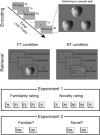The pupillary response discriminates between subjective and objective familiarity and novelty
- PMID: 26174940
- PMCID: PMC4737255
- DOI: 10.1111/psyp.12471
The pupillary response discriminates between subjective and objective familiarity and novelty
Abstract
The pupil response discriminates between old and new stimuli, with old stimuli characterized by larger pupil dilation patterns than new stimuli. We sought to explore the cause of the pupil old/new effect and discount the effect of targetness, effort, recollection retrieval, and complexity of the recognition decision. Two experiments are reported in which the pupil response and the eye fixation patterns were measured, while participants identified novel and familiar object stimuli, in two separate tasks, emphasizing either novelty or familiarity detection. In Experiment 1, familiarity and novelty decisions were taken using a rating scale, while in Experiment 2 a simpler yes/no decision was used. In both experiments, we found that detection of target familiar stimuli resulted in greater pupil dilation than the detection of target novel stimuli, while the duration of the first fixation discriminated between familiar and novel stimuli as early as within 320 ms after stimulus onset. Importantly, the pupil response distinguished between the objective (during an earlier temporal component) and the subjective (during a later temporal component) status of the stimulus for misses and false alarms. In the light of previous findings, we suggest that the pupil and fixation old/new effects reflect the distinct neural and cognitive mechanisms involved in the familiarity and novelty decisions. The findings also have important implications for the use of pupil dilation and eye movement patterns to explore explicit and implicit memory processes.
Keywords: Familiarity; Novelty; Pupil old/new effect; Pupil response; Recognition memory.
© 2015 The Authors. Psychophysiology published by Wiley Periodicals, Inc. on behalf of Society for Psychophysiological Research.
Figures




Similar articles
-
How do memory systems detect and respond to novelty?Neurosci Lett. 2018 Jul 27;680:60-68. doi: 10.1016/j.neulet.2018.01.053. Epub 2018 Feb 3. Neurosci Lett. 2018. PMID: 29408218 Free PMC article. Review.
-
Familiarity and recollection produce distinct eye movement, pupil and medial temporal lobe responses when memory strength is matched.Neuropsychologia. 2012 Nov;50(13):3080-93. doi: 10.1016/j.neuropsychologia.2012.08.001. Epub 2012 Aug 10. Neuropsychologia. 2012. PMID: 22902538
-
Recognition memory strength is predicted by pupillary responses at encoding while fixation patterns distinguish recollection from familiarity.Q J Exp Psychol (Hove). 2011 Oct;64(10):1971-89. doi: 10.1080/17470218.2011.588335. Epub 2011 Aug 15. Q J Exp Psychol (Hove). 2011. PMID: 21838656
-
The pupil as an indicator of unconscious memory: Introducing the pupil priming effect.Psychophysiology. 2015 Jun;52(6):754-69. doi: 10.1111/psyp.12412. Epub 2015 Feb 5. Psychophysiology. 2015. PMID: 25656874
-
Age differences in the neural correlates of novelty processing: The effects of item-relatedness.Brain Res. 2015 Jul 1;1612:2-15. doi: 10.1016/j.brainres.2014.08.006. Epub 2014 Aug 19. Brain Res. 2015. PMID: 25149192 Review.
Cited by
-
How do memory systems detect and respond to novelty?Neurosci Lett. 2018 Jul 27;680:60-68. doi: 10.1016/j.neulet.2018.01.053. Epub 2018 Feb 3. Neurosci Lett. 2018. PMID: 29408218 Free PMC article. Review.
-
Commentary: Pupil old/new effects reflect stimulus encoding and decoding in short-term memory.Front Psychol. 2017 Feb 28;8:277. doi: 10.3389/fpsyg.2017.00277. eCollection 2017. Front Psychol. 2017. PMID: 28293207 Free PMC article. No abstract available.
-
Rapid Brain Responses to Familiar vs. Unfamiliar Music - an EEG and Pupillometry study.Sci Rep. 2019 Oct 30;9(1):15570. doi: 10.1038/s41598-019-51759-9. Sci Rep. 2019. PMID: 31666553 Free PMC article.
-
Is Pupil Activity Associated With the Strength of Memory Signal for Words in a Continuous Recognition Memory Paradigm?Front Psychol. 2021 Nov 23;12:686183. doi: 10.3389/fpsyg.2021.686183. eCollection 2021. Front Psychol. 2021. PMID: 34887795 Free PMC article.
-
Applicability and usefulness of pupillometry in the study of lexical access. A scoping review of primary research.Front Psychol. 2024 Mar 11;15:1372912. doi: 10.3389/fpsyg.2024.1372912. eCollection 2024. Front Psychol. 2024. PMID: 38529093 Free PMC article.
References
-
- Ariel, R. , & Castel, A. D. (2014). Eyes wide open: Enhanced pupil dilation when selectively studying important information. Experimental Brain Research, 232, 337–44. doi: 10.1007/s00221-013-3744-5 - DOI - PMC - PubMed
-
- Beatty, J. (1982). Task‐evoked pupillary responses, processing load, and the structure of processing resources. Psychological Bulletin, 91, 276–292. - PubMed
-
- Beatty, J. , & Lucero‐Wagoner, B. (2000). The pupillary system In Cacioppo J. T., Tassinary L. G., & Berntson G. G. (Eds.), Handbook of psychophysiology (pp. 142–162). New York, NY: Cambridge University Press.
-
- Cheng, A. C. K. , Rao, S. K. , Cheng, L. L. , & Lam, D. S. C. (2006). Assessment of pupil size under different light intensities using the Procyon pupillometer. Journal of Cataract & Refractive Surgery, 32, 1015–1017. - PubMed
-
- Daselaar, S. M. , Fleck, M. S. , Prince, S. E. , & Cabeza, R. (2006). The medial temporal lobe distinguishes old from new independently of consciousness. Journal of Neuroscience, 26, 5835–5839. doi: 10.1523/jneurosci.0258-06.2006 - DOI - PMC - PubMed
MeSH terms
LinkOut - more resources
Full Text Sources
Other Literature Sources

